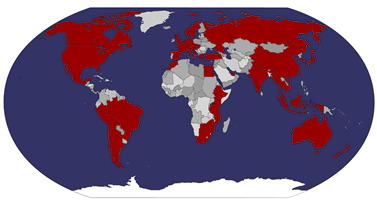
My room!

No time for breakfast, as I have a boat to catch. Before leaving, Salam, one of the maid girls, wants me to take and print her photo, which she explains in an amusing way, dropping her voice conspiratorially to a whisper, holding up three fingers, and talking away in Amharic. I haven’t a clue what she’s on about!

On the way to the boat area, near Tana Hotel, I pop into the Ethiopian air office, and find the domestic flight to Gonder the following morning is full! What a nuisance! Never mind, the afternoon flight has space.
I notice the airline clocks are on Ethiopian time, which is amazing really – I’ve been in several places in the world that supposedly have their own time systems, but have never actually seen them used in practice. Here though, 6am is 12, and so on, and they actually set their clocks like this. So 8:45am as it is now becomes 2:45! I’m especially surprised to see the airlines using this system, but now I think about it, the internet café computers were also all set to these funny times!
Incidentally, they also use a different calendar – the Julian one, and so on 12th September 2007, they reached their millennium year (2000) which they are still celebrating now. The Julian calendar was introduced by Julius Caesar in 45BC, and consists of 12 months of equal duration, plus a 13th month of five days (six in a leap year). In 1582 the Gregorian calendar was introduced, a modified version which was brought in to correct perceived inaccuracies in the Julian calendar, in particular the shifting of Easter from springtime into summer due to the shifting equinoxes. In many aspects Ethiopia takes an orthodox position, and choice of calendar was no different – they stuck to the Julian system, with New Year falling on 1 Meskerem, or 11th September (12th on leap years), signifying the end of the rainy season and beginning of spring.
Round near Tana Hotel, I find the boat area, just off the lakeside walkway. On the way, I note that the traditional dress has dramatically changed, from Masai in Kenya and Tanzania, with their jewellery, and red and purple chequered wraps, to here where people wear a large headscarf wrapped several times around their head, tiny shorts and a shawl or plain robes wrapped around upper body. Apparently Ethiopians have always had a strong sense of pride, especially as they’re the only East African nation to have successfully repulsed European invasions (Italians), but some of this pride has worn off due to the efforts of the do-good NGOs, encouraging dependency on foreign aid. Indeed, the Prime Minister of Ethiopia, Meles Zenawi, has recently commented on the misguided approach of the EU to the current Kenyan crisis – by threatening to suspend aid to the region to force democracy on the region. He notes that the West does nothing to force democracy on our allies in the Middle East, such as the UAE, the Saudis etc.
At the boat area, I am forced to break several negotiation rules – I have to deal with someone who doesn’t own the boats but speaks on behalf of the drivers, I have to haggle with a group present, etc. The chap I speak to claims it’s 400 birr. My LP book (2007) says it should be 120. I haggle for half an hour, eventually he is down to 250b, whereas I say 200 is my last price, so I actually resign myself to not going to the monasteries, and walk away.
Five minutes’ walk and one of the drivers chases me down, and agrees to 200b. Just shows you, you have to be able to walk away if you’re going to haggle properly.

This chap’s name is Amlucky (no, really), and he has the lucky task of boating me around three monasteries and showing me the Blue Nile. Two of the monasteries are on islands, and the third is next to the start of the Blue Nile river as it flows gently out of Lake Tana, which according to Amlucky is Africa’s 3rd biggest lake. I’m somewhat dubious about this fact when looking at my map, as I can see at least four or five which look far bigger than Tana, but I’ll take his word for it. It’s certainly a big lake, and one cannot see the other side, about 84km to the north.

Around the lake there are over 30 monasteries, 19 of which have or have had monasteries on them, thankfully only three of which I’ll visit today (they had been trying to persuade me to join a group going to more distant ones too). The monasteries are believed to rest on earlier religious sites and include the thirteenth century Debre Mariam, the eighteenth century Narga Selassie and Tana Qirqos (said to have housed the Ark of the Covenant before it was moved to Axum).
We chug slowly over to the first island, and I try to stay out of the sun which is quite strong now, as we pass near some rocks hosting what looks like hundreds of pelicans.

The odd cormorant floats about on the water, and I see what I think are white-necked (white-collared?) eagles soaring above.


Amlucky shows me around each island, the first of which, Entos Eysesu, dates from the 14th century.

We climb up the island, past coffee plants. You’d never guess from the unripe beans what can be made by the end of processing and roasting.

We pass the cave where the first monk resident here used to pray.

Not very hospitable
There is a small office, and then the monastery at the top of the hill.



It has recently painted murals of various scenes from the bible around an inner room designed to hold the Arc of the Covenant,



plus some ancient books, some made out of goat skin and apparently dating from the time the monastery was built!

Amlucky shows me a book that is about 700 years old

I’m amazed how nonchalantly the monks whip out these ancient books and flip through them for you. They are illustrated with lots of pictures, coming from a time when many could not read.

Next is Kibran St. Gabriel Monastery.

Women are not allowed in this one, and so must wait in the boats or on the jetty whilst the men get down to business.

A helpful monk explains the history to me, and shows me some of their treasures in the small museum.


I should mention that all of these monasteries charge 30 birr entry fee, plus of course you can donate more if you so wish. They all also have a very curious set up outside – two long “planks” of stone, suspended with ropes one above the other, with a small rock sitting on top of one of the stones. By tapping the large stone with the small, one finds the stones emitting a surprisingly-loud bell-like tone.

Inside the actual monastery, there are very old paintings, many of which are covered to protect them.



The Source of the Blue Nile
We head back across to where the Blue Nile exits the lake.

Apparently one can see hippos here, but they tend to hide from the mid-day sun. One doesn’t see many people swimming in the lake – apparently it contains Bilharzia, the small worms that bury themselves in your skin and then move to your bowel or bladder, which is a good enough reason to stay out of it! It was the 18th Century explorer James Bruce who traced the Blue Nile up to here (the White Nile flows from Lake Victoria, south of here, then they meet at Khartoum in Sudan). As we reach the mouth, a chap pushes himself using a pole across on a tankwa, a locally-made canoe, made out of papyrus reeds growing by the lake shore.

The level of the lake is controlled by a weir just downstream of here, feeding the hydro-power station near the Tis Abay falls. Here we stop at the last of the three monasteries, the oldest too, Debra-Mariam, dating from the 13th century.


Again, mediaeval paintings and some very old books. Interesting, but I’ve had enough by now.


We boat back, and I tip Amlucky 50b, as he’s been very good natured and has done his best as a guide too, which I wasn’t expecting.

I walk back to the Zimmanesh building that I stay in, past a strange cactus tree

and the local job advert wall

and lunch in the Blue Jayz Restaurant downstairs. I want to eat local food, so pick with not much help from the giggly waitress girls one of the “National Dishes”, Shiro. It’s a good choice, tasty, some kind of lentil dish, a bit spicy, and comes in black pot which the waitress tips on to my pancake.

I think it’s one of the dishes I had the day before with Atsedeweyn. Plenty of food too, despite the waitress telling me it wasn’t much when I ordered it.
As I eat, I try to read Henry James’s An American Scene. It’s written in such a shockingly-boring style. Perhaps I’m jumping to conclusions too soon, but it’s the first classic book I’ve ever had where the introduction written by someone else is far more interesting than the opening chapters of the book! I finish with a coffee, then use the internet a bit. It costs 0.20 birr per minute, so about a penny a minute.




1 comment:
thanks for the post card, it arrived on my birthday!
Post a Comment